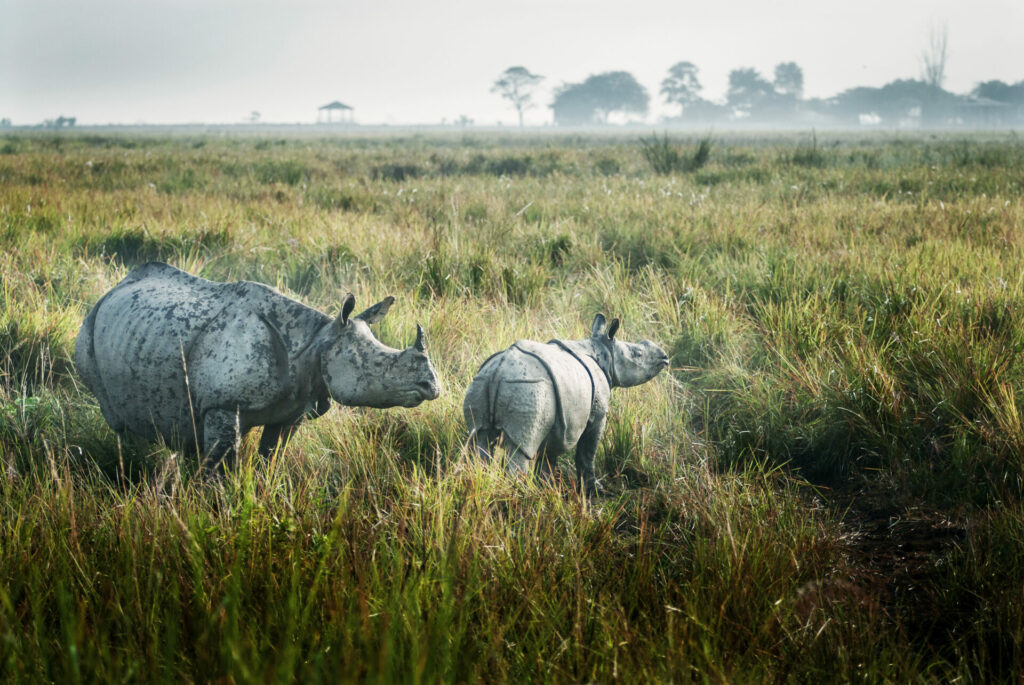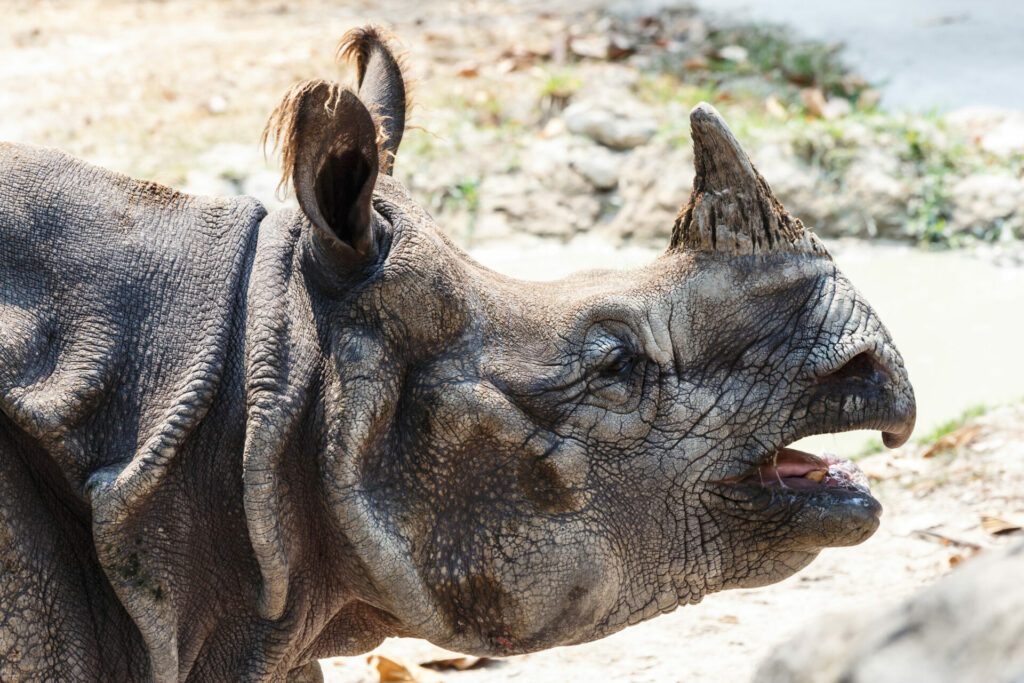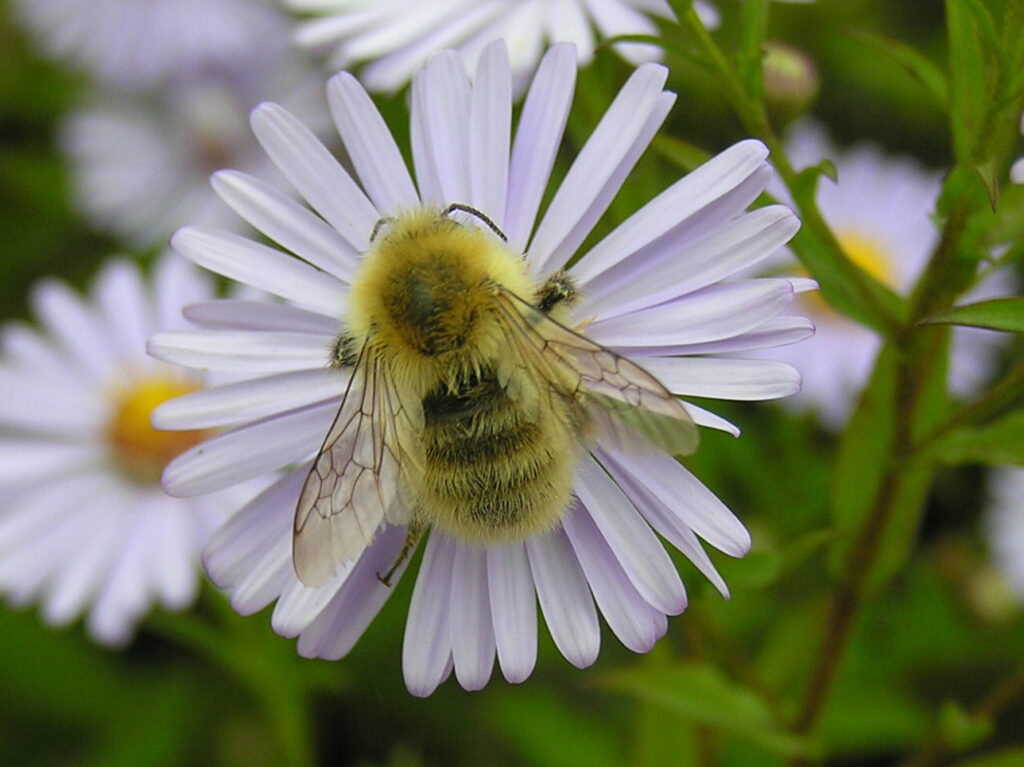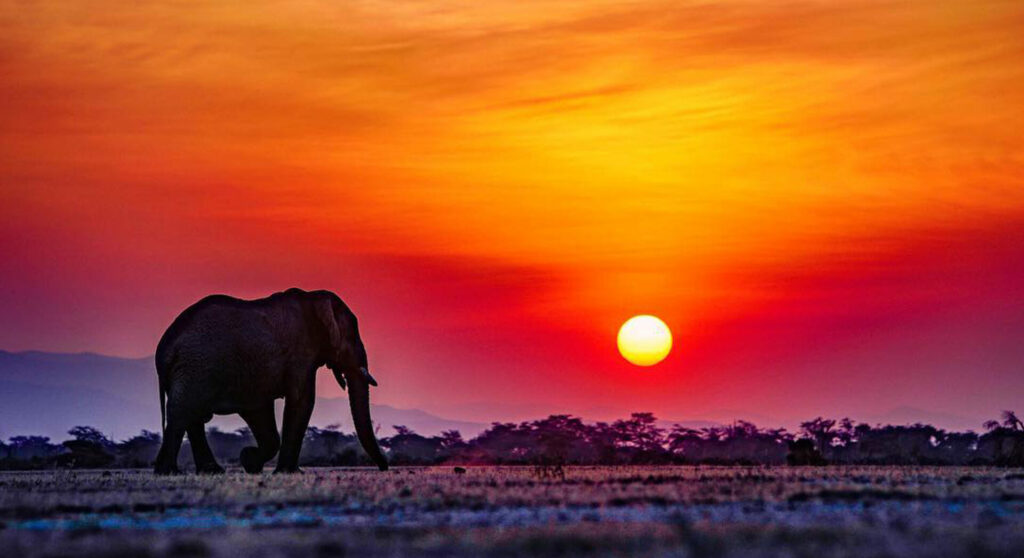Officially the largest land animal after the elephant, rhinos have called earth home for some 50 million years. Of the 100 different species, only five now remain.
While the plight of Africa’s grass-eating pachyderms is well documented, their greater one-horned Asian cousins continue to roam largely under the radar. Also known as Indian rhinos or rhinoceros unicorns, these mega herbivores have many names but just one distinctive look thanks to their brownish-grey armour-like skin and single black horn.
They were once a common site across their native India’s northern plains, yet now the greater one-horned rhino is now restricted to fewer than a dozen National Parks and protected reserves.
Already extinct in Bangladesh, Myanmar and Pakistan, their global population was whittled down to a pitiful 100 individuals by 1960, making their down-listing from ‘endangered’ to ‘vulnerable’ on the International Union for Conservation of Nature’s (IUCN) Red List of Threatened Species in 2008 an even more remarkable feat.

According to the International Rhino Foundation, 4,000 of these prehistoric-looking beasts now graze in the grasslands and wallow in the wetlands of northern India, southern Nepal and Bhutan.
But this keystone species – critical to both the health of wider ecosystems and their inhabitants – aren’t out of the (riverine) woods just yet. Habitat loss, being hunted for their horns, human-wildlife conflict and even invasive plants are keeping these massive mammals very much on their three toes.
Plant Danger
Having been driven to near-extinction by deforestation and poaching in the 1960s, Nepal’s now 752-strong population of greater one-horned rhinos are rebounding, with 90 per cent inhabiting the Himalayan nation’s southern-central Chitwan National Park.
Despite being skilled swimmers, these semi-aquatic animals’ newest nemesis risks death by drowning. A non-native plant, the sun-loving lantana camara, indiscriminately entangles the rhinos, causing them to quite literally get stuck in the mud.
The climate crisis could render a third of Nepal’s rhino habitat unsuitable in the next half century
It’s estimated that a third of the greater one-horned rhinos grassland range in Chitwan has already been invaded by a type of American creeper called mikania micrantha. And it’s a problem that’s predicted only to worsen with a warming planet.
‘The impact of climate change will trigger invasive species and severe flooding in the prime habitat in Chitwan,’ Bhagawan Dahal, The Zoological Society of London’s (ZSL) Deputy Country Manager in Nepal, tells The Ethicalist. ‘While habitats in Bardia and Shuklaphanta [two other Nepalese national parks] will be affected by drought and forest fire.’
A study by the Department of National Parks and Wildlife Conservation in Nepal suggests that climate change could render a third of Nepal’s rhino habitat unsuitable in the next half century.
For the time being, there are conservation wins to be celebrated. Dahal says Bardia’s resident rhinos have gone from nine to 38 between 2015 and 2021, while Shuklaphanta’s wild population has increased from nine to 17 over the same period thanks to successful translocations from Chitwan. Meanwhile, Koshi Tappu Wildlife Reserve in the country’s eastern corner is being eyed for Nepal’s next rhino reintroduction.
But it’s not quite as simple as just dropping these armour-plated giants, which can weigh up to 2.7 tons, into their favourite tall grasses. Central to ZSL’s greater one-horned rhino conservation initiatives in Nepal are the locals living in the buffer forest zone of National Parks and protected reserves.
These tank-like animals may be capable of moving at speeds of 35 miles per hour, but they can’t outrun electrocution, poisoning and snares set by hunters.
This community-focused approach is motivated by ‘reducing their [humans] impact on rhino habitats,’ says Dahal, be that through anti-poaching patrols, the creation of veterinary clinics to curb disease outbreaks in livestock or teaching sustainable grazing practices to farmers.
‘Healthy grasslands provide a continuous supply of nutritious foraging for rhinos,’ he explains of this critical food source. Combine with riverine forests and swamps, and you have the perfect habitat for these mega herbivores to flourish.

But even though the most recent census revealed a 16 per cent uptick in Nepal’s greater one-horned rhino populations between 2015 and 2021, the statistic by no means tells the whole story. Nepal’s Department of National Parks and Wildlife Conservation reported the deaths of 37 of these grass-eating pachyderms in Chitwan in 2021. This included two at the hands of hunters, breaking the park’s four-year-long poaching-free-record.
Park Versus Poachers
Some 700 miles away in India’s north-eastern province of Assam, these supersized mammals have established a stronghold in an area historically blighted by decades of poaching.
Home to 70 per cent of the world’s greater one-horned rhinos, 270-square-mile Kaziranga National Park mourned the slaughter of 27 rhinos in 2013 to 2014. These tank-like animals may be capable of moving at speeds of 35 miles per hour, but they can’t outrun electrocution, poisoning and snares set by hunters.
Mistakenly believed to have medicinal qualities, the horns of rhinos – made from the same protein as our own finger and toe nails – continue to be in high demand in China and Vietnam. Ground up into a powder and dissolved in boiling water, the bogus cure is used in traditional Chinese medicine to treat everything from food poisoning to fevers. According to the WWF (World Wildlife Fund), rhino horn can command as much as $132,000 per lb on the black market.
Dehorning rhinos is now commonplace in some reserves in African countries such as Namibia, South Africa and Zimbabwe, but Dr Bibhab Kumar Talukdar says this extreme conservation measure would be unjustified on the Indian subcontinent.
As Chair of the IUCN’s Asian Rhino Specialist Group and CEO of Northeast India’s leading wildlife NGO Aaranyak he tells The Ethicalist: ‘For dehorning we need to dart rhinos which are high cost and risk. Rhino poaching has been vastly under control in India and Nepal.’
Dog Patrols
This is in part thanks to sniffer dogs – that track poachers and detect everything from explosives to horns – which Aaranyak has helped introduce to four of Assam’s protected areas.
To date, three canine units have been deployed in UNESCO World Heritage-listed Kaziranga, which nestles on the banks of the mighty Brahmaputra River. The park’s multifaceted approach to protecting its greater one-horned rhinos is also benefiting the 150 Royal Bengal tigers and 250 leopards that live here.
As well as arming their anti-Poaching Task Force, which was established in 2016, with more sophisticated weaponry, artificial mud platforms have been built specifically for rhinos to take refuge during the monsoon floods.
Growing Rhino Population
A population count carried out last May by 400 forest park officers, together with a fleet of drones, confirmed a total of 2,613 greater one-horned rhinos in Kaziranga, including 146 calves. That’s an increase of 200 in five years, impressive when you consider the painfully slow reproduction of these mega herbivores, which birth one calf every two to three years.
All of Assam’s parks – including Bhutanese border-straddling Manas and birding hotspot Orang – are closed off to visitors during the greater one-horned rhinos’ breeding season.
But an expanding rhino population needs space, and lots of it to avoid conflict with people. Last September, Orang National Park more than doubled in size to accommodate its 125 resident rhinos, while Kaziranga – where greater one-horned rhinos are regularly transplanted from – is set to be extended by a further 130-acres.
Encouragingly, there was only one recorded rhino poaching incident in India during 2021 according to The International Rhino Foundation and none in Kaziranga National Park. But the arrest of 55 poachers in Assam last year is proof that the demand for rhinos’ 60cm-long prized horns is not waning.
While these once-endangered armour-plated giants are bouncing back, there’s no room for complacency. Let’s not forget that these keystone species still only inhabit a fraction of their once vast former range.













